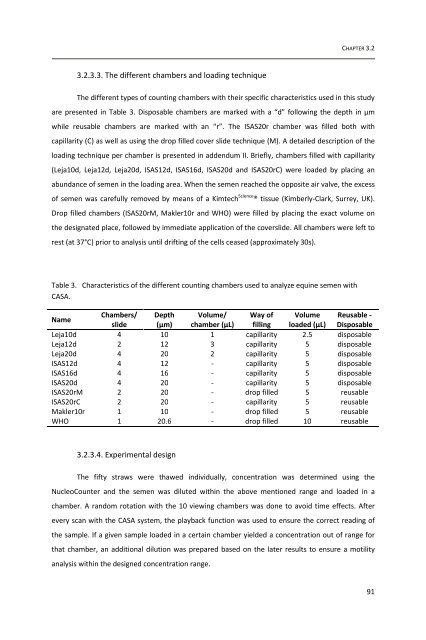view - Department of Reproduction, Obstetrics and Herd Health
view - Department of Reproduction, Obstetrics and Herd Health
view - Department of Reproduction, Obstetrics and Herd Health
Create successful ePaper yourself
Turn your PDF publications into a flip-book with our unique Google optimized e-Paper software.
3.2.3.3. The different chambers <strong>and</strong> loading technique<br />
CHAPTER 3.2<br />
The different types <strong>of</strong> counting chambers with their specific characteristics used in this study<br />
are presented in Table 3. Disposable chambers are marked with a “d” following the depth in µm<br />
while reusable chambers are marked with an “r”. The ISAS20r chamber was filled both with<br />
capillarity (C) as well as using the drop filled cover slide technique (M). A detailed description <strong>of</strong> the<br />
loading technique per chamber is presented in addendum II. Briefly, chambers filled with capillarity<br />
(Leja10d, Leja12d, Leja20d, ISAS12d, ISAS16d, ISAS20d <strong>and</strong> ISAS20rC) were loaded by placing an<br />
abundance <strong>of</strong> semen in the loading area. When the semen reached the opposite air valve, the excess<br />
<strong>of</strong> semen was carefully removed by means <strong>of</strong> a Kimtech Science ® tissue (Kimberly-Clark, Surrey, UK).<br />
Drop filled chambers (ISAS20rM, Makler10r <strong>and</strong> WHO) were filled by placing the exact volume on<br />
the designated place, followed by immediate application <strong>of</strong> the coverslide. All chambers were left to<br />
rest (at 37°C) prior to analysis until drifting <strong>of</strong> the cells ceased (approximately 30s).<br />
Table 3. Characteristics <strong>of</strong> the different counting chambers used to analyze equine semen with<br />
CASA.<br />
Name<br />
Chambers/<br />
slide<br />
Depth<br />
(µm)<br />
Volume/<br />
chamber (µL)<br />
Way <strong>of</strong><br />
filling<br />
Volume<br />
loaded (µL)<br />
Reusable -<br />
Disposable<br />
Leja10d 4 10 1 capillarity 2.5 disposable<br />
Leja12d 2 12 3 capillarity 5 disposable<br />
Leja20d 4 20 2 capillarity 5 disposable<br />
ISAS12d 4 12 - capillarity 5 disposable<br />
ISAS16d 4 16 - capillarity 5 disposable<br />
ISAS20d 4 20 - capillarity 5 disposable<br />
ISAS20rM 2 20 - drop filled 5 reusable<br />
ISAS20rC 2 20 - capillarity 5 reusable<br />
Makler10r 1 10 - drop filled 5 reusable<br />
WHO 1 20.6 - drop filled 10 reusable<br />
3.2.3.4. Experimental design<br />
The fifty straws were thawed individually, concentration was determined using the<br />
NucleoCounter <strong>and</strong> the semen was diluted within the above mentioned range <strong>and</strong> loaded in a<br />
chamber. A r<strong>and</strong>om rotation with the 10 <strong>view</strong>ing chambers was done to avoid time effects. After<br />
every scan with the CASA system, the playback function was used to ensure the correct reading <strong>of</strong><br />
the sample. If a given sample loaded in a certain chamber yielded a concentration out <strong>of</strong> range for<br />
that chamber, an additional dilution was prepared based on the later results to ensure a motility<br />
analysis within the designed concentration range.<br />
91









